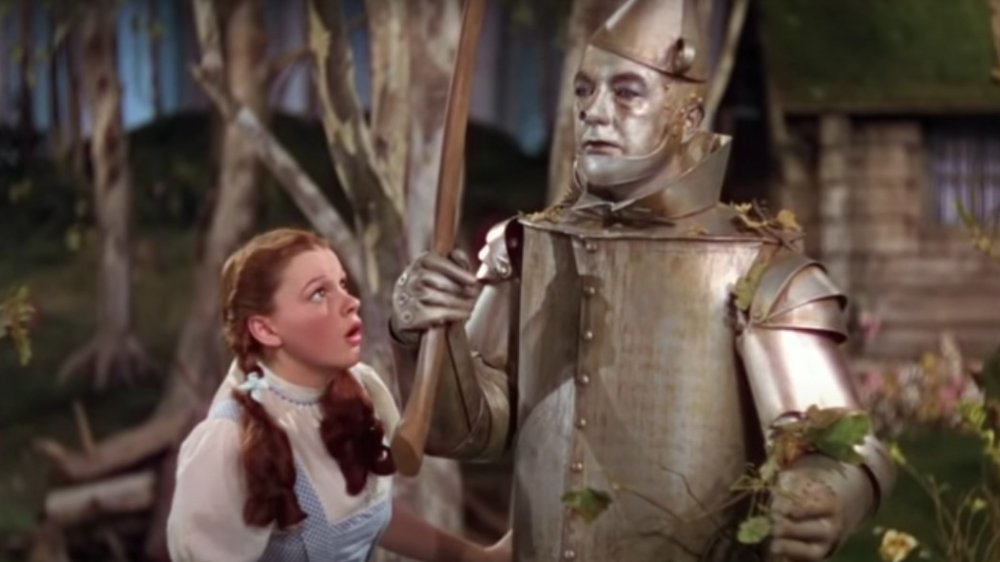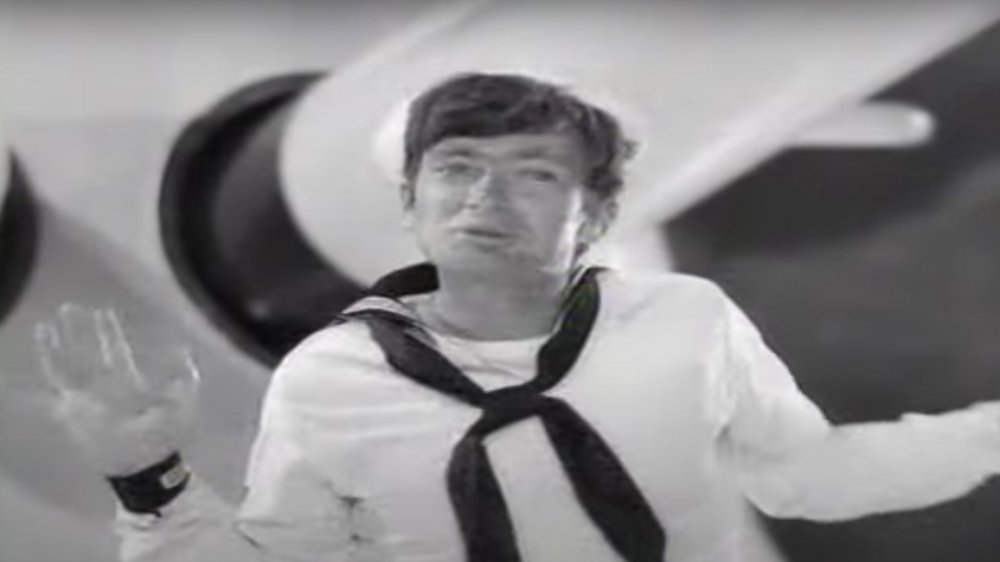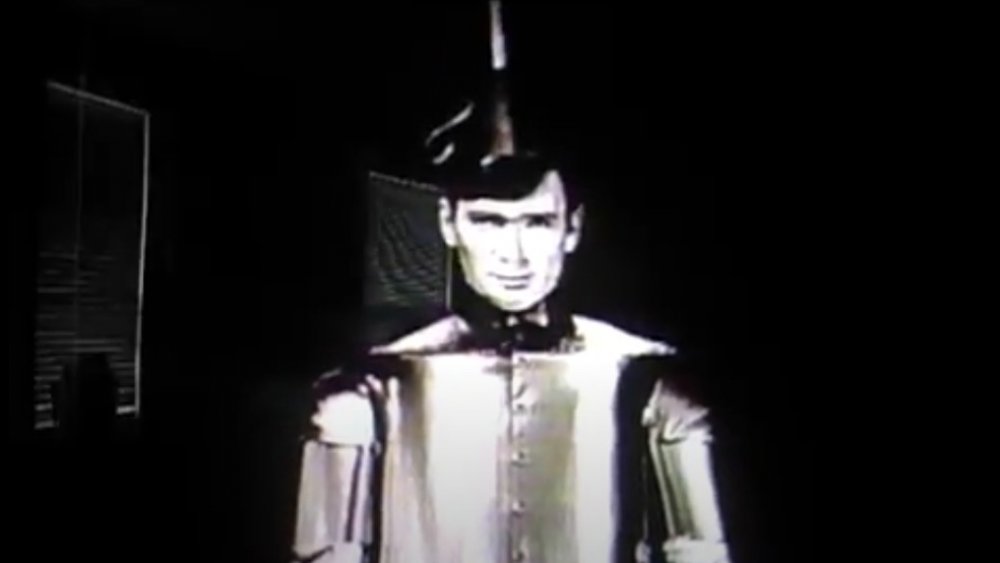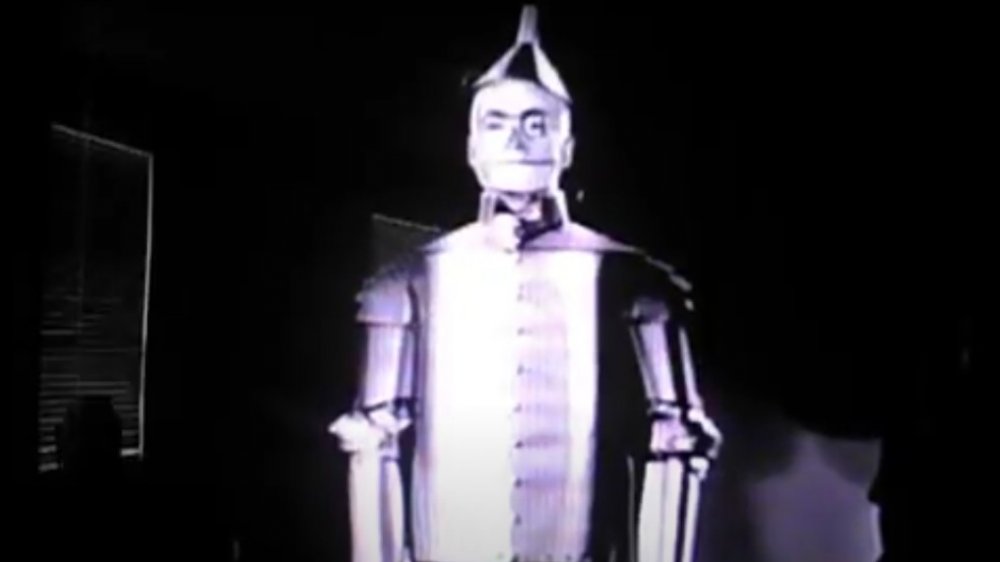Why The Tin Man Was The Most Dangerous Role In The Wizard Of Oz
The "Golden Age" of Hollywood produced some of the most endearing and enduring films of American cinema, but its human resources record is a little on the sketchy side. Actors were very much a commodity, and while a highly successful actor could count on the power and resources of a studio in times of trouble, for the lesser mortals, it was a job that paid better than digging ditches. Per Civilized, in the beginning, live ammunition was fired at actors, who presumably learned to duck. Horses and other animals were regularly crippled or killed in the course of stunt work (it was hard on the human beings, too). Alfred Hitchcock, whose career started in silent films, didn't say actors were cattle, but he did say that actors should be treated like cattle, reports The Telegraph. And while some truly great movies were made, they came at a cost. Often, a human cost.
The Wizard of Oz, released in 1939, was no exception. Margaret Hamilton, who played Almira Gulch as well as the Wicked Witch of the West, departed Munchkinland in smoke and flames and caught fire doing it. She suffered a second-degree burn on her face and a third-degree burn on her hand, as Vintage News tells us.
Buddy Ebsen was a veteran of vaudeville and Broadway
She had to leave filming for several weeks to recover and agreed to return to the set under one condition: "No more fireworks!" The studio apparently agreed, but her stunt double, Betty Danko, didn't get the memo; Danko also was burned, while filming the "Surrender Dorothy" skywriting sequence.
You might be taking a deep breath at this point and muttering, "Thank goodness nobody died." Except one actor very nearly did. Buddy Ebsen was born Christian Rudolf Ebsen Jr. in 1908, says Hometowns to Hollywood. He's probably best remembered for his role as Jed Clampett in endless reruns of The Beverly Hillbillies, along with a decent run as a geriatric private investigator in Barnaby Jones and Fess Parker's sidekick Georgie Russell in the Disney version of Davy Crockett.
But he started out as a hoofer, working with one of his sisters in a duo act. According to his Associate Press obituary, published by the Tulsa World, the two of them performed on Broadway, as well as in supper clubs and on the vaudeville circuit, before she stepped back and he went solo. He was dancing in MGM musicals in the 1930s, including appearances with darling Shirley Temple, when he was tagged for a part in the studio's production of The Wizard of Oz.
Costuming for the Tin Man was experimental
Mental Floss tells us that originally, Ebsen was cast as the Scarecrow and Ray Bolger, another Broadway veteran, was slated for the part of the Tin Man. Bolger convinced the studio that his style of dancing was more suited to the looseness of the Scarecrow (debatable, if you ever watched Ebsen dance) and he switched parts with Buddy. And while Bolger certainly commanded the screen as the Scarecrow, he was probably grateful for the transfer for other reasons.
One of the problems the production faced in those happy pre-CGI days was costuming and makeup — how to make a human being look like he was made out of tin? Various ideas were trotted out, says ThoughtCo, including actual tin; silvery paper; cardboard covered with silver cloth — the usual sorts of solutions for your run-of-the-mill grade school play. Then someone got the brilliant idea of using white base makeup with aluminum powder sprinkled on. Brilliant.
What could possibly go wrong?
Except it wasn't. Ebsen was well along in the role — he'd recorded the soundtrack, rehearsed choreography, been fitted for costumes, reports Snopes, — but nine days into shooting he couldn't, well, breathe. Which, we can all agree, is pretty important for a dancer, or anyone else, for that matter. "I was sure I was dying," he wrote in his autobiography. He'd had an allergic reaction of some kind to the makeup concoction. The next stop was the hospital, where he was to remain for two weeks, followed by another four weeks recuperating in San Diego.
The studio, ever mindful of its actors, replaced Ebsen with Jack Haley as the Tin Man. The base-plus-dust was replaced with a paste that was painted on. Even that wasn't perfect; Haley developed an eye infection from the gunk, which caused him to miss four days of shooting. But he didn't lose his eye as a result. Or his life. Or his job.
While they replaced Ebsen on film, his voice is still heard in Oz's soundtrack, in "We're Off to See the Wizard." Even better, ThoughtCo points out that Buddy outlived Bolger and Haley both; the original Tin Man died in 2003 at the age of 95.



